Рынок цифровых двойников в здравоохранении: текущий анализ и прогноз (2024–2032 гг.)
Акцент на типе (цифровой двойник процесса и системы и цифровой двойник продукта); применение (управление активами и процессами, персонализированная медицина, открытие лекарств и другое); конечный пользователь (больницы и клиники, организации клинических исследований и другие); регион/страна.
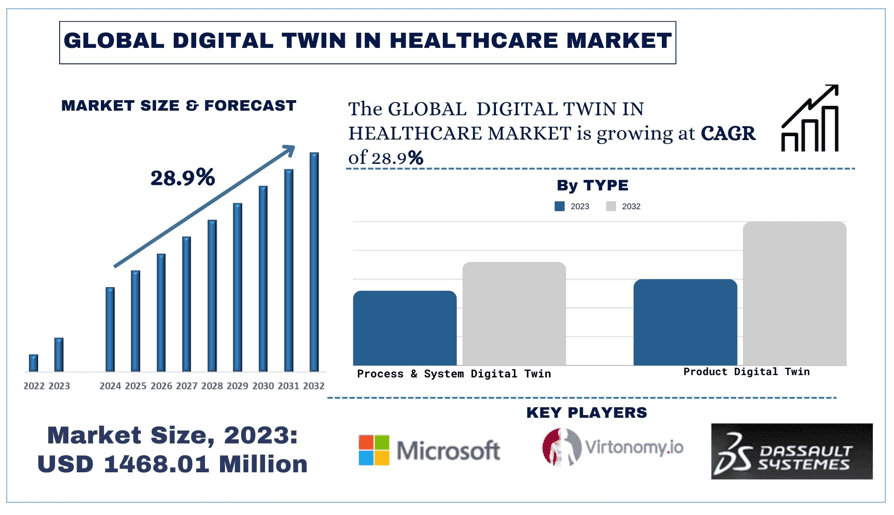
Размер и прогноз рынка цифровых двойников в здравоохранении
Объем рынка цифровых двойников в здравоохранении был оценен в 1468,01 млн долларов США, и ожидается, что в течение прогнозируемого периода (2024-2032 гг.) он будет расти со значительным среднегодовым темпом роста (CAGR) около 28,9% благодаря инвестициям в цифровые двойники.
Анализ рынка цифровых двойников в здравоохранении
В последние годы цифровые двойники стали преобразующей силой в различных отраслях, включая здравоохранение. Основанные на моделировании, анализе данных и Интернете вещей (IoT), цифровые двойники предлагают виртуальную копию физических объектов — будь то машина, процесс или, в контексте здравоохранения, пациент. Эта инновация использует передовые технологии для создания всеобъемлющего цифрового аналога профиля здоровья человека, включая физиологические параметры, историю болезни, генетический состав и факторы образа жизни.
- Недавняя правительственная статистика за 2023 год подчеркивает стремление Китая к повышению доступности и качества здравоохранения. Страна делает значительные инвестиции в цифровую инфраструктуру и инновации для улучшения своей системы здравоохранения. Эти инвестиции имеют решающее значение, поскольку Китай сталкивается с растущей эпидемией сердечно-сосудистых заболеваний (ССЗ), причем, согласно исследованию, опубликованному Национальным центром биотехнологической информации (NCBI), более 3 миллионов смертей каждый год приписываются ССЗ.
- В 2023 году Siemens Healthineers в партнерстве с NHS Foundation Trusts внедрила решения цифровых двойников для профилактического обслуживания медицинского оборудования. Эта инициатива направлена на повышение качества обслуживания и сокращение времени простоя оборудования, демонстрируя практические преимущества технологии цифровых двойников в здравоохранении.
Тенденции рынка цифровых двойников в здравоохранении
В этом разделе рассматриваются ключевые тенденции рынка, которые влияют на различные сегменты рынка цифровых двойников в здравоохранении, как определено нашей командой экспертов по исследованиям.
Сегмент продуктовых цифровых двойников, трансформирующий отрасль
Сегмент продуктовых цифровых двойников на рынке цифровых двойников в здравоохранении представляет собой поворотный момент в использовании технологий для улучшения оказания медицинской помощи и результатов лечения. Цифровые двойники в здравоохранении обычно включают создание виртуальных копий физических объектов, включая медицинские устройства, органы или целые системы здравоохранения. Эти цифровые копии используются для многочисленных приложений, таких как управление активами, открытие лекарств и персонализированная медицина, что обеспечивает глубокое понимание и оптимизацию процессов здравоохранения. В последние годы наблюдались значительные инновации и финансирование в этом сегменте. Например, в октябре 2023 года стартап Leucine привлек 7 миллионов долларов США в рамках финансирования серии «A» для расширения своей платформы цифровых двойников на основе искусственного интеллекта, предназначенной для производителей лекарств. Эта платформа направлена на оптимизацию соблюдения нормативных требований и оптимизацию производственных процессов.
Ожидается, что Северная Америка будет расти со значительным среднегодовым темпом роста в течение прогнозируемого периода
В Северной Америке на рынке цифровых двойников в здравоохранении доминируют Соединенные Штаты. Этот рост обусловлен несколькими факторами. Достижения в области технологий, особенно в IoT, искусственном интеллекте и анализе больших данных, позволили создать сложные решения цифровых двойников, которые могут точно моделировать и имитировать сложные сценарии здравоохранения. Кроме того, растущее внимание к оказанию медицинской помощи на основе ценности и пациентоориентированным подходам привело к спросу на решения, которые повышают эффективность, снижают затраты и улучшают клинические результаты. Кроме того, недавние партнерства между поставщиками медицинских услуг, технологическими фирмами и исследовательскими институтами по разработке и внедрению решений цифровых двойников подчеркивают импульс, продвигающий рынок цифровых двойников в здравоохранении Северной Америки.
Например, в 2023 году Google Health объявила о своем сотрудничестве с ведущими поставщиками медицинских услуг по использованию технологии цифровых двойников для прогнозной аналитики и персонализированного ухода за пациентами.
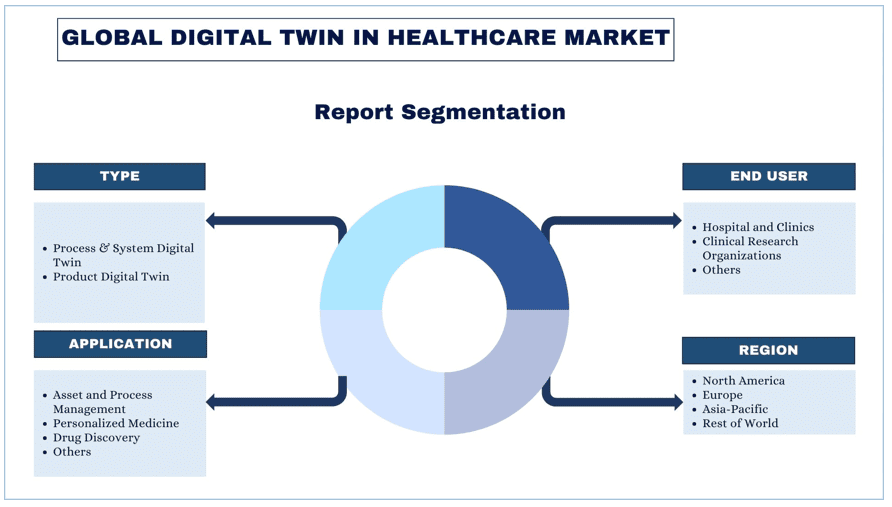
Обзор индустрии цифровых двойников в здравоохранении
Рынок цифровых двойников в здравоохранении является конкурентным и фрагментированным, с присутствием нескольких глобальных и международных игроков рынка. Ключевые игроки применяют различные стратегии роста для расширения своего присутствия на рынке, такие как партнерства, соглашения, сотрудничество, запуск новых продуктов, географическое расширение, а также слияния и поглощения. Некоторыми из основных игроков, работающих на рынке, являются Atos SE; Koninklijke Philips N.V.; Altair Engineering Inc.; Verto Health; Twin Health; Dassault Systèmes; PrediSurge; Virtonomy GmbH; Siemens Healthineers AG’; и Microsoft.
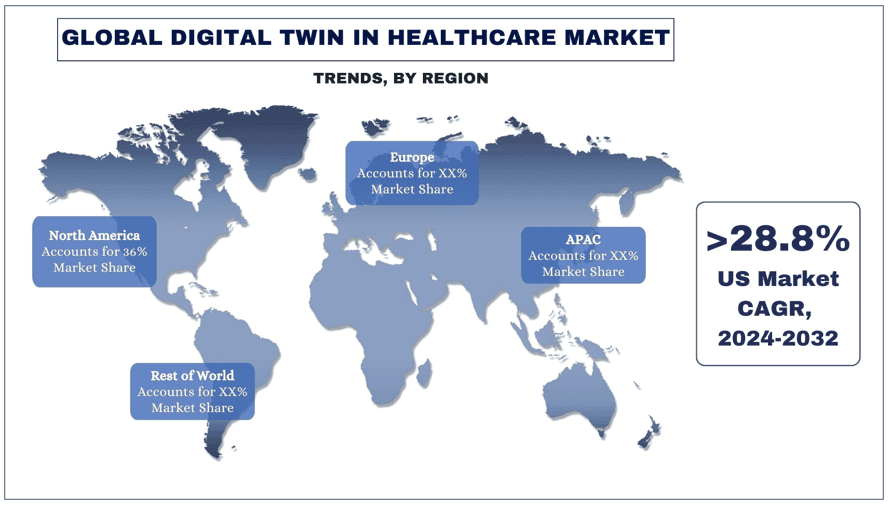
Новости рынка цифровых двойников в здравоохранении
- В январе 2024 года генеральный директор Siemens обсудил преобразующий потенциал цифровых двойников во время основного доклада на CES 2024, подчеркнув их роль в промышленной метавселенной и здравоохранении. Основное внимание было уделено повышению эффективности и точности задач с помощью цифрового моделирования и искусственного интеллекта.
- В марте 2024 года компания Twin Health привлекла 50 миллионов долларов США для расширения своей технологии цифрового двойника всего тела, направленной на революцию в профилактике и обращении вспять хронических метаболических заболеваний. Это финансирование поможет расширить их новаторскую услугу для дальнейшего применения в здравоохранении.
Охват отчета о рынке цифровых двойников в здравоохранении
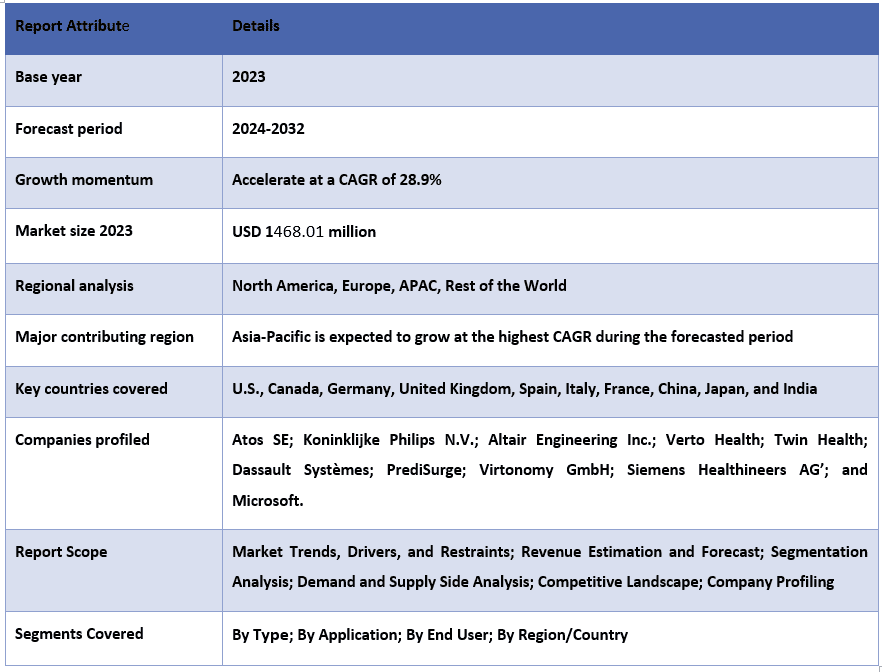
Причины купить этот отчет:
- Исследование включает анализ размеров рынка и прогнозирование, подтвержденные аутентифицированными ключевыми экспертами отрасли.
- Отчет представляет собой краткий обзор общей эффективности отрасли с первого взгляда.
- Отчет охватывает углубленный анализ видных отраслевых аналогов с основным упором на ключевые финансовые показатели бизнеса, продуктовые портфели, стратегии расширения и последние разработки.
- Подробное изучение движущих сил, ограничений, ключевых тенденций и возможностей, преобладающих в отрасли.
- Исследование всесторонне охватывает рынок по различным сегментам.
- Углубленный анализ отрасли на региональном уровне.
Варианты настройки:
Глобальный рынок цифровых двойников в здравоохранении может быть дополнительно настроен в соответствии с требованиями или любым другим сегментом рынка. Кроме того, UMI понимает, что у вас могут быть свои собственные бизнес-потребности, поэтому не стесняйтесь связаться с нами, чтобы получить отчет, который полностью соответствует вашим требованиям.
Содержание
Методология исследования для анализа рынка цифровых двойников в здравоохранении (2024-2032 гг.)
Анализ исторического рынка, оценка текущего рынка и прогнозирование будущего рынка глобального рынка цифровых двойников в здравоохранении были тремя основными этапами, предпринятыми для создания и анализа внедрения цифровых двойников в здравоохранении в основных регионах мира. Было проведено исчерпывающее вторичное исследование для сбора исторических данных о рынке и оценки текущего размера рынка. Во-вторых, для подтверждения этих выводов было принято во внимание множество результатов и предположений. Кроме того, были проведены исчерпывающие первичные интервью с отраслевыми экспертами по всей цепочке создания стоимости глобального рынка цифровых двойников в здравоохранении. После предположения и подтверждения рыночных показателей посредством первичных интервью мы использовали подход "сверху вниз/снизу вверх" для прогнозирования общего размера рынка. После этого были приняты методы разбивки рынка и триангуляции данных для оценки и анализа размера рынка сегментов и подсегментов соответствующей отрасли. Подробная методология объясняется ниже:
Анализ исторического размера рынка
Этап 1: Углубленное изучение вторичных источников:
Было проведено подробное вторичное исследование для получения исторических данных о размере рынка цифровых двойников в здравоохранении из внутренних источников компании, таких как годовые отчеты и финансовые отчеты, презентации результатов деятельности, пресс-релизы и т. д., и внешних источников, включая журналы, новости и статьи, правительственные публикации, публикации конкурентов, отраслевые отчеты, сторонние базы данных и другие надежные публикации.
Этап 2: Сегментация рынка:
После получения исторических данных о размере рынка цифровых двойников в здравоохранении мы провели подробный вторичный анализ для сбора исторических рыночных данных и доли для различных сегментов и подсегментов для основных регионов. Основные сегменты, включенные в отчет, - это тип, применение и конечный пользователь. Был проведен дальнейший анализ на уровне стран для оценки общего внедрения моделей тестирования в этом регионе.
Этап 3: Факторный анализ:
После получения исторических данных о размере рынка различных сегментов и подсегментов мы провели подробный факторный анализ для оценки текущего размера рынка цифровых двойников в здравоохранении. Кроме того, мы провели факторный анализ с использованием зависимых и независимых переменных, таких как тип, применение и конечный пользователь цифрового двойника на рынке здравоохранения. Был проведен тщательный анализ сценариев спроса и предложения с учетом ведущих партнерств, слияний и поглощений, расширения бизнеса и запуска продуктов в секторе рынка цифровых двойников в здравоохранении по всему миру.
Оценка текущего размера рынка и прогноз
Определение текущего размера рынка: На основе действенных данных, полученных на основе вышеуказанных 3 этапов, мы пришли к выводу о текущем размере рынка, ключевых игроках на глобальном рынке цифровых двойников в здравоохранении и рыночных долях сегментов. Все необходимые процентные доли и разбивки рынка были определены с использованием вышеупомянутого вторичного подхода и были проверены посредством первичных интервью.
Оценка и прогнозирование: Для оценки и прогнозирования рынка различным факторам были присвоены веса, включая драйверы и тенденции, ограничения и возможности, доступные для заинтересованных сторон. После анализа этих факторов были применены соответствующие методы прогнозирования, то есть подход "сверху вниз/снизу вверх", чтобы получить прогноз рынка на 2030 год для различных сегментов и подсегментов на основных рынках мира. Методология исследования, принятая для оценки размера рынка, включает в себя:
- Размер рынка отрасли с точки зрения выручки (в долларах США) и темпы внедрения цифровых двойников в здравоохранении на основных рынках внутри страны
- Все процентные доли, разбивки и деления сегментов и подсегментов рынка
- Ключевые игроки на глобальном рынке цифровых двойников в здравоохранении с точки зрения предлагаемой продукции. Кроме того, стратегии роста, принятые этими игроками для конкуренции на быстрорастущем рынке
Подтверждение размера и доли рынка
Первичное исследование: Были проведены углубленные интервью с ключевыми лидерами общественного мнения (KOL), включая руководителей высшего звена (CXO/вице-президенты, руководители отдела продаж, руководители отдела маркетинга, руководители операционного отдела, региональные руководители, руководители стран и т. д.) в основных регионах. Затем были обобщены результаты первичных исследований и проведен статистический анализ для доказательства заявленной гипотезы. Данные, полученные в результате первичных исследований, были объединены с результатами вторичных исследований, тем самым превратив информацию в действенные данные.
Распределение участников первичного опроса по разным регионам
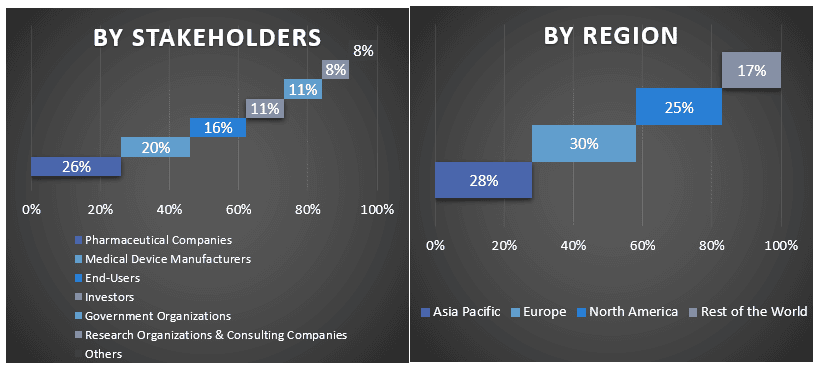
Инжиниринг рынка
Метод триангуляции данных был использован для завершения общей оценки рынка и получения точных статистических данных для каждого сегмента и подсегмента глобального рынка цифровых двойников в здравоохранении. Данные были разделены на несколько сегментов и подсегментов после изучения различных параметров и тенденций в областях типа, применения и конечного пользователя на глобальном рынке цифровых двойников в здравоохранении.
Основная цель исследования глобального рынка цифровых двойников в здравоохранении
В исследовании были точно определены текущие и будущие рыночные тенденции глобального рынка цифровых двойников в здравоохранении. Инвесторы могут получить стратегическое представление для обоснования своих решений об инвестициях на основе качественного и количественного анализа, выполненного в исследовании. Текущие и будущие рыночные тенденции определили общую привлекательность рынка на региональном уровне, предоставив платформу для промышленного участника для использования неиспользованного рынка и получения выгоды от преимущества первопроходца. Другие количественные цели исследований включают в себя:
- Анализ текущего и прогнозируемого размера рынка цифровых двойников в здравоохранении с точки зрения стоимости (в долларах США). Кроме того, проанализируйте текущий и прогнозируемый размер рынка различных сегментов и подсегментов
- Сегменты в исследовании включают области типа, применения и конечного пользователя
- Определение и анализ нормативно-правовой базы для индустрии цифровых двойников в здравоохранении
- Анализ цепочки создания стоимости с участием различных посредников, а также анализ поведения клиентов и конкурентов в отрасли
- Анализ текущего и прогнозируемого размера рынка цифровых двойников в здравоохранении для основного региона
- Основные страны регионов, изученные в отчете, включают Азиатско-Тихоокеанский регион, Европу, Северную Америку и остальной мир
- Профили компаний рынка цифровых двойников в здравоохранении и стратегии роста, принятые участниками рынка для поддержания устойчивости на быстрорастущем рынке
- Углубленный анализ отрасли на региональном уровне
Часто задаваемые вопросы Часто задаваемые вопросы
В1: Каков текущий размер рынка и потенциал роста рынка цифровых двойников в здравоохранении?
Q2: Каковы основные факторы роста рынка цифровых двойников в здравоохранении?
Q3: Какой сегмент имеет наибольшую долю рынка цифровых двойников в здравоохранении по типу?
Q4: Каковы новые технологии и тенденции на рынке цифровых двойников в здравоохранении?
Q5: Какой регион будет доминировать на рынке цифровых двойников в здравоохранении?
Связанные Отчеты
Клиенты, купившие этот товар, также купили










